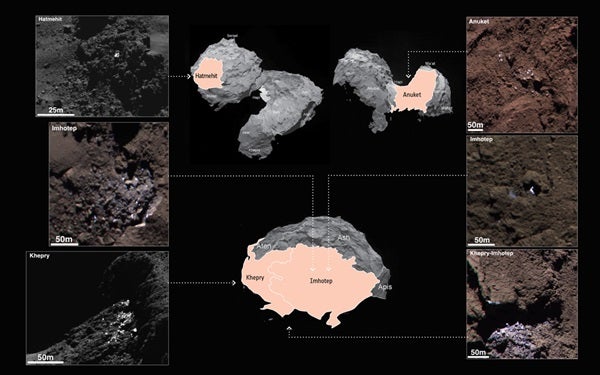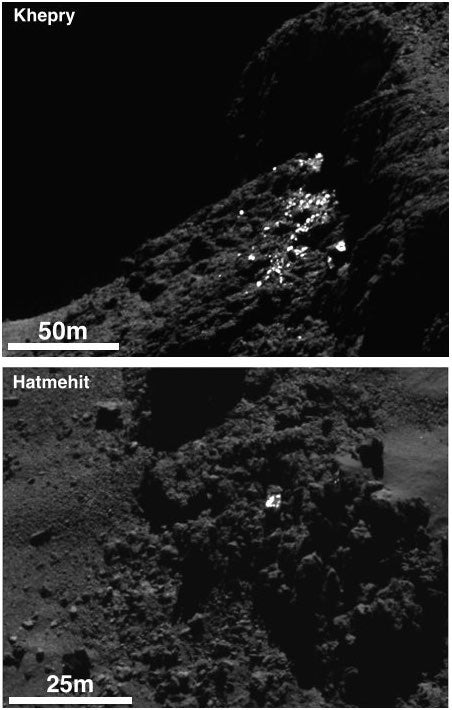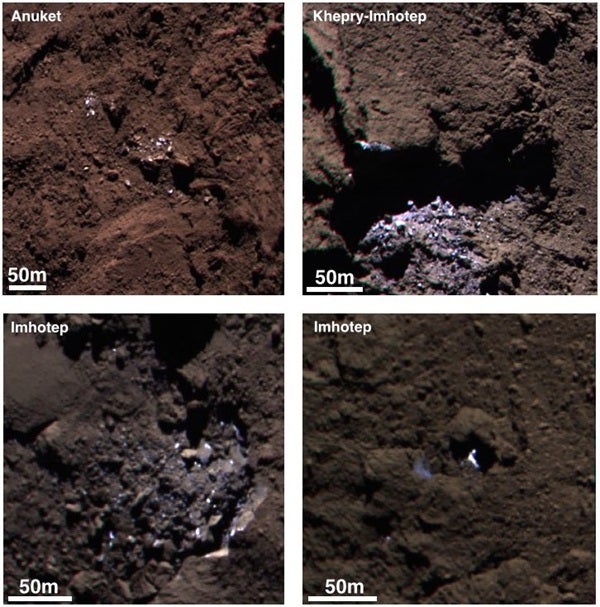Examples of six different bright patches identified on the surface of Comet 67P/Churyumov-Gerasimenko in OSIRIS narrow-angle camera images acquired in September 2014. The insets point to the broad regions in which they were discovered (not to specific locations). In total, 120 bright regions, including clusters of bright features, isolated features and individual boulders, were identified in images acquired during September 2014 when the spacecraft was between 10–30 miles (20-50km) from the comet center.
On the left-hand side of the image, a boulder with icy patches in Hatmehit (top), a cluster of icy features in Imhotep (middle), and a cluster in Khepry (bottom) is presented; on the right-hand side a cluster in Anuket (top), a bright feature in Imhotep (middle), and a cluster close to the Khepry-Imhotep boundary (bottom) is shown.
The false color images are red-green-blue composites assembled from monochrome images taken at different times and have been stretched and slightly saturated to emphasize the contrasts of color such that dark terrains appear redder and bright regions appear significantly bluer compared with what the human eye would normally see. This imaging technique allows scientists to determine more about the nature of the material; in this case the bluer color indicates the presence of ice.
Rosetta arrived at the comet in August 2014 at a distance of about 60 miles (100 kilometers) and eventually orbited the comet at 6 miles (10km) or less, allowing high-resolution images of the surface to be acquired.
A new study focuses on an analysis of bright patches of exposed ice on the comet’s surface.
Based on observations of the gas emerging from comets, they are known to be rich in ices. As they move closer to the Sun along their orbits, their surfaces are warmed and the ices sublimate into gas, which streams away from the nucleus, dragging along dust particles embedded in the ice to form the coma and tail.
But some of the comet’s dust also remains on the surface as the ice below sublimates, or falls back on to the nucleus elsewhere, coating it with a thin layer of dusty material and leaving little ice directly exposed on the surface. These processes help explain why Comet 67P/Churyumov-Gerasimenko and other comets seen in previous flyby missions are so dark.
Despite this, Rosetta’s suite of instruments has already detected a variety of gases, including water vapor, carbon dioxide, and carbon monoxide, thought to originate from frozen reservoirs below the surface.
Now, using images taken with Rosetta’s OSIRIS narrow-angle camera last September, scientists have identified 120 regions on the surface of Comet 67P/Churyumov-Gerasimenko that are up to 10 times brighter than the average surface brightness.
Example of a cluster of bright spots on Comet 67P/Churyumov-Gerasimenko found in the Khepry region (top) and an individual boulder with bright patches on its surface in the Hatmehit region (bottom). The bright patches are thought to be exposures of water-ice.
In total, 120 bright areas like these were identified in images acquired during September 2014. Both images shown here are subsets of OSIRIS narrow-angle camera images taken on September 30 when the spacecraft was about 12 miles (20km) from the comet center.
The clusters of bright features, comprising a few tens of meter-sized boulders spread over several tens of meters, are typically found in debris fields at the base of cliffs. They are most likely the result of recent erosion or collapse of the cliff wall revealing fresher material from below the dust-covered surface.
By contrast, some of the isolated bright objects are found in regions without any apparent relation to the surrounding terrain. These are thought to be objects lifted up from elsewhere on the comet during a period of cometary activity, but with insufficient velocity to escape the gravitational pull of the comet completely.
In all cases, however, the bright patches were found in areas that receive relatively little solar energy, such as in the shadow of a cliff, and no significant changes were observed between images taken over a period of about a month. Furthermore, they were found to be bluer in color at visible wavelengths compared with the redder background, consistent with an icy component.
“Water ice is the most plausible explanation for the occurrence and properties of these features,” said Antoine Pommerol of the University of Bern.
“At the time of our observations, the comet was far enough from the Sun such that the rate at which water ice would sublimate would have been less than 1 millimeter per hour of incident solar energy. By contrast, if carbon dioxide or carbon monoxide ice had been exposed, it would have rapidly sublimated when illuminated by the same amount of sunlight. Thus we would not expect to see that type of ice stable on the surface at this time.”
Examples of icy bright patches seen on Comet 67P/Churyumov-Gerasimenko during September 2014. The two left-hand images are subsets of OSIRIS narrow-angle camera images acquired on September 5; the right-hand images were acquired on September 16. During this time the spacecraft was about 18-25 miles (30–40km) from the comet center.
The images are false color red-green-blue composites assembled from monochrome images acquired at different times with the 882.1nm (red), 649.2nm (green), and 360.0nm (blue) channels. Each channel was stretched and slightly saturated to emphasis the contrasts of color across the scene such that dark terrains appear redder and bright regions appear significantly bluer compared with what a human eye would normally see.
While various ices mixed with dust would be consistent with the blue signature, taken with other observations, the various properties of the bright patches point to water-ice.
“A 1-millimeter-thick layer of dark dust is sufficient to hide the layers below from optical instruments,” said Holger Sierks from the Max Planck Institute for Solar System Research in Göttingen.
“The relatively homogeneous dark surface of the nucleus of Comet 67P/Churyumov-Gerasimenko, only punctuated by some meter-scale bright dots, can be explained by the presence of a thin dust mantle composed of refractory mineral and organic matter, with the bright spots corresponding to areas from which the dust mantle was removed, revealing a water-ice-rich subsurface below.”
The team also speculates about the timing of the formation of the icy patches. One hypothesis is that they were formed at the time of the last closest approach of the comet to the Sun, 6.5 years ago, with icy blocks ejected into permanently shadowed regions, preserving them for several years below the peak temperature needed for sublimation.
Another idea is that even at relatively large distances from the Sun, carbon dioxide and carbon monoxide-driven activity could eject the icy blocks. In this scenario, it is assumed that the temperature was not yet high enough for water sublimation, such that the water-ice-rich components outlive any exposed carbon dioxide or carbon monoxide ice.
“As the comet continues to approach perihelion, the increase in solar illumination onto the bright patches that were once in shadow should cause changes in their appearance, and we may expect to see new and even larger regions of exposed ice,” said Matt Taylor from ESA.
“Combining OSIRIS observations made pre- and post-perihelion with other instruments will provide valuable insight into what drives the formation and evolution of such regions.”












